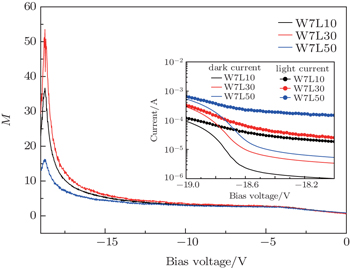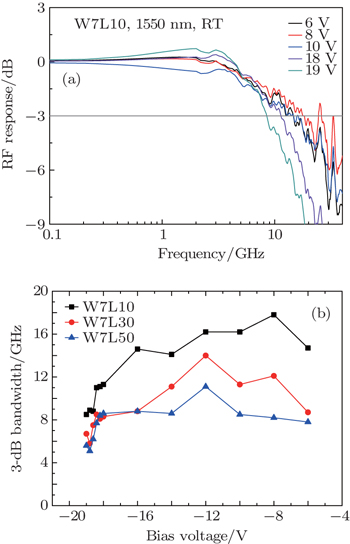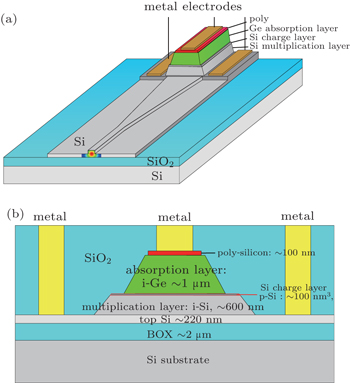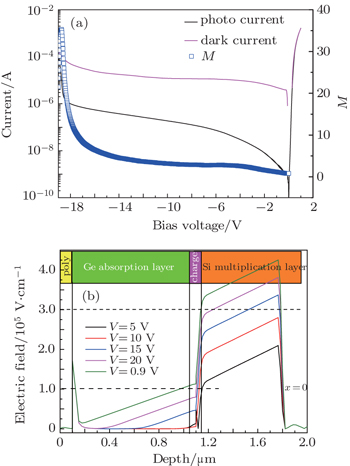† Corresponding author. E-mail:
Project supported by the National State Basic Research Program of China (Grant No. 2013CB632103) and the National Natural Science Foundation of China (Grant Nos. 61177038, 61377045, and 61176013).
Waveguide-integrated Ge/Si heterostructure avalanche photodetectors (APDs) were designed and fabricated using a CMOS-compatible process on 8-inch SOI substrate. The structure of the APD was designed as separate-absorption-charge-multiplication (SACM) using germanium and silicon as absorption region and multiplication region, respectively. The breakdown voltage (Vb) of such a device is 19 V at reverse bias and dark current appears to be 0.71 μA at 90% of the Vb. The device with a 10-μm length and 7-μm width of Ge layer shows a maximum 3-dB bandwidth of 17.8 GHz at the wavelength of 1550 nm. For the device with a 30-μm-length Ge region, gain-bandwidth product achieves 325 GHz.
Avalanche photodetectors (APDs) are widely used in fiber-optic communications due to their internal carrier multiplication mechanism.[1,2] The applications of conventional III–V compound semiconductor APDs are limited because of their low gain-bandwidth products.[3–5] Their typical values are in the range of 100–150 GHz, which make them less attractive for high-speed communication. Silicon (Si) is considered the best material for the multiplication layer in an APD in contrast to other bulk semiconductors because of its low ratio of the ionization coefficients of electrons and holes (0.01–0.1).[6,7] In addition, compared with other semiconductors, Si shows a very low temperature dependence on the avalanche breakdown.[8] Thus Ge/Si APDs with separated-absorption-charge-multiplication (SACM) structure have become greatly promising for high response and high speed at 1550 nm wavelength.[9,10] Using germanium and silicon as absorption and multiplication layer respectively, could effectively avoid the carrier feedback loops caused by carrier multiplication in the absorbing region.[11] The fact that Ge has similar crystal structure and material characteristics to Si makes the design and manufacture of APDs compatible with the existing CMOS process technology. The above advantages could achieve properties of high gain-bandwidth products, low noise, temperature independence and low cost for APDs. Recent advancement reveals that group-IV materials could be promising candidates for manufacturing high-performance APDs. The first Si-waveguide-integrated Ge/Si APD was fabricated by Zhu et al., which has a responsivity of 7.2 A/W at 1550 nm with a 3-dB bandwidth of 3.3 GHz.[12] Kang et al. have demonstrated a top illuminated Ge/Si APD with a quite high gain-bandwidth product of 340 GHz and a sensitivity of −28 dBm at a photon wavelength of 1310 nm.[13]
In this paper, we demonstrate waveguide-integrated Ge/Si SACM APDs with selective epitaxial growth germanium and silicon waveguide on 8-inch SOI substrate.[14] A step-coupler was designed for high efficient vertical coupling between Si waveguide and Ge/Si APD.[15] The crystal quality of the epi-Ge absorption layer is better than that of non-selective growth. These features ensure that such an APD has a very low dark current and high optical absorption. We designed and fabricated the waveguide-integrated Ge/Si APD in order to further improve both speed and responsivity with a smaller area of depletion capacitance and longer germanium absorption region than vertical incidence APD.[16]
Waveguide-integrated Ge/Si avalanche photodetector design features a separate-absorption-charge-multiplication (SACM) configuration in which germanium and silicon were employed for light absorption and carrier multiplication, respectively. The device fabrication was started from an 8-inch Si-on-insulator (SOI) substrate with a 220-nm-thick silicon top layer and a 2-μm-thick buried oxide. Channel waveguide with a taper width of 180 nm was first formed for light guidance and electrical isolation, and the taper was designed to improve the efficiency of coupling light to the optical fiber. Ion implantation of arsenic dopants was performed to form the bottom n-type layer, followed by high-dose phosphorus implantation to form a good n-type Ohmic contact. A 10-nm-thick oxide window was formed for selective Si epitaxy. The epi-Si layer with a thickness of 700 nm was grown using an ultra-high vacuum chemical vapor deposition (UHVCVD) reactor, which was followed by boron implantation to form a p-type charge layer. After the formation of another oxide window, a 1-μm-thick hetero-epitaxy Ge layer was selectively grown using the same UHVCVD reactor. Then a 100-nm-thick poly silicon was deposited and followed by a high dose of boron ion implantation. The dopants were activated at 750 °C for 3 minutes in the atmosphere of nitrogen to form a good p-type Ohmic contact. Finally a 1.5-μm-thick TaN/Al was deposited and metalized.
The schematic configuration of an evanescently coupled waveguide APD is shown in Fig.
The measured dark current and photocurrent of a typical 10-μm-length device at room temperature are shown in Fig.
When the bias is less than punch-through voltage, the depletion region is solely confined in the silicon region. The dark current from simulation is flat and in the sub-nA level, the measured dark current is much larger than the level. The main reason is the quality of the epitaxial silicon layer. In the Ge absorption region, incident photons are absorbed and photocarriers generated. Under reverse bias, the holes are swept toward the p+ contact and electrons toward the n+ contact. When traveling in the Si multiplication region with a high electric field, electrons primarily undergo a series of impact ionizations, creating more electron–hole pairs, which consequently amplifies photocurrent.
The electric field distribution was calculated along the longitudinal cross section of a waveguide-integrated Ge/Si APD. Figure
In order to characterize the optical response, a single-mode lensed fiber was used for injecting light at a wavelength of 1550 nm into the Si waveguide. The primary responsivity was measured using a conventional waveguide-integrated Ge/Si p–i–i–n detector with the same geometric structure, and the measured result is 0.8 A/W. By normalizing the measured APD’s responsivity to the primary responsivity of the reference detector, the multiplication (M) gain factor can be calculated. In Fig.
 | Fig. 3. Multiplication factors M of devices with different lengths of Ge layer; inset figure shows dark and light currents of these devices before break-down. |
The electrical 3-dB-bandwidth of the waveguide-integrated Ge/Si APD was measured using a Yenista tunable laser, Sumitomo Osaka cement 40 Gbps intensity modulator and an Anritus Vector Network Analyzer at 1550 nm. Figure

 | Fig. 4. (a) RF response for APD with 10-μm-length Ge layer at reverse bias of 6 V, 8 V, 10 V, 18 V, and 19 V; (b) 3-dB-bandwidth versus bias voltage for devices with different lengths of Ge layer. |
In Eq. (
A waveguide-integrated Ge/Si avalanche photodetector (APD) featuring separate-absorption-charge-multiplication (SACM) was demonstrated using a CMOS-compatible process on 8-inch SOI platform. The device with a length of 30-μm Ge layer achieved a multiplication gain factor of 53 for a C-band communication wavelength of 1550 nm. The maximum 3-dB-bandwidth for the APD was 17.8 GHz at a reverse bias voltage of 8 V for the device with 10-μm-length Ge layer. By considering both optical and RF response, the largest gain-bandwidth product was 325 GHz for the device with 30-μm-length absorption region under a reverse bias of 18.6 V.
| 1 | |
| 2 | |
| 3 | |
| 4 | |
| 5 | |
| 6 | |
| 7 | |
| 8 | |
| 9 | |
| 10 | |
| 11 | |
| 12 | |
| 13 | |
| 14 | |
| 15 | |
| 16 |





